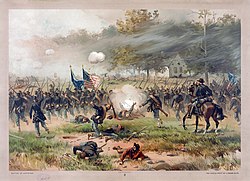Contents
- Incumbents
- Federal government
- Governors
- Lieutenant governors
- Events
- January
- February
- March
- April
- May
- June
- July
- August
- September
- October
- November
- December
- Undated
- Ongoing
- Births
- Deaths
- See also
- References
- Further reading
- External links
| |||||
| Decades: | |||||
|---|---|---|---|---|---|
| See also: | |||||

Events from the year 1862 in the United States.





